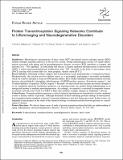| dc.contributor.author | Nakamura, Tomohiro | |
| dc.contributor.author | Oh, Chang-ki | |
| dc.contributor.author | Zhang, Xu | |
| dc.contributor.author | Tannenbaum, Steven R | |
| dc.contributor.author | Lipton, Stuart A | |
| dc.date.accessioned | 2021-10-27T20:24:34Z | |
| dc.date.available | 2021-10-27T20:24:34Z | |
| dc.date.issued | 2021 | |
| dc.identifier.uri | https://hdl.handle.net/1721.1/135673 | |
| dc.description.abstract | Significance: Physiological concentrations of nitric oxide (NO•) and related reactive nitrogen species (RNS) mediate multiple signaling pathways in the nervous system. During inflammaging (chronic low-grade inflammation associated with aging) and in neurodegenerative diseases, excessive RNS contribute to synaptic and neuronal loss. "NO signaling" in both health and disease is largely mediated through protein S-nitrosylation (SNO), a redox-based posttranslational modification with "NO" (possibly in the form of nitrosonium cation [NO+]) reacting with cysteine thiol (or, more properly, thiolate anion [R-S-]). Recent Advances: Emerging evidence suggests that S-nitrosylation occurs predominantly via transnitros(yl)ation. Mechanistically, the reaction involves thiolate anion, as a nucleophile, performing a reversible nucleophilic attack on a nitroso nitrogen to form an SNO-protein adduct. Prior studies identified transnitrosylation reactions between glyceraldehyde-3-phosphate dehydrogenase (GAPDH)-nuclear proteins, thioredoxin-caspase-3, and X-linked inhibitor of apoptosis (XIAP)-caspase-3. Recently, we discovered that enzymes previously thought to act in completely disparate biochemical pathways can transnitrosylate one another during inflammaging in an unexpected manner to mediate neurodegeneration. Accordingly, we reported a concerted tricomponent transnitrosylation network from Uch-L1-to-Cdk5-to-Drp1 that mediates synaptic damage in Alzheimer's disease. Critical Issues: Transnitrosylation represents a critical chemical mechanism for transduction of redox-mediated events to distinct subsets of proteins. Although thousands of thiol-containing proteins undergo S-nitrosylation, how transnitrosylation regulates a myriad of neuronal attributes is just now being uncovered. In this review, we highlight recent progress in the study of the chemical biology of transnitrosylation between proteins as a mechanism of disease. Future Directions: We discuss future areas of study of protein transnitrosylation that link our understanding of aging, inflammation, and neurodegenerative diseases. Antioxid. Redox Signal. 35, 531-550. | |
| dc.language.iso | en | |
| dc.publisher | Mary Ann Liebert Inc | |
| dc.relation.isversionof | 10.1089/ars.2021.0081 | |
| dc.rights | Article is made available in accordance with the publisher's policy and may be subject to US copyright law. Please refer to the publisher's site for terms of use. | |
| dc.source | Mary Ann Liebert | |
| dc.title | Protein Transnitrosylation Signaling Networks Contribute to Inflammaging and Neurodegenerative Disorders | |
| dc.type | Article | |
| dc.contributor.department | Massachusetts Institute of Technology. Department of Biological Engineering | |
| dc.relation.journal | Antioxidants and Redox Signaling | |
| dc.eprint.version | Final published version | |
| dc.type.uri | http://purl.org/eprint/type/JournalArticle | |
| eprint.status | http://purl.org/eprint/status/PeerReviewed | |
| dc.date.updated | 2021-09-10T14:54:09Z | |
| dspace.orderedauthors | Nakamura, T; Oh, C-K; Zhang, X; Tannenbaum, SR; Lipton, SA | |
| dspace.date.submission | 2021-09-10T14:54:11Z | |
| mit.journal.volume | 35 | |
| mit.journal.issue | 7 | |
| mit.license | PUBLISHER_POLICY | |
| mit.metadata.status | Authority Work and Publication Information Needed | |
